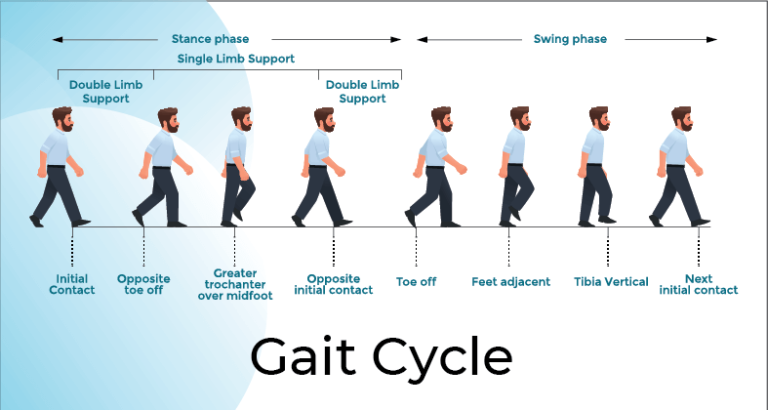
What comes to your mind when you hear “Gait Analysis”?
Probably the images of complex, expensive labs with high-end equipment and graphs that seem impossible to interpret.
You might have learned the theory of Gait quite in detail, including but not limited to the Phases, Kinematics, Kinetics, and EMG. Although, in most colleges and syllabi, Gait Analysis practicals are limited to Observational Gait Analysis and the “Chalk Powder” Practical for the spatial parameters.
Furthermore, only Observational Gait Analysis commonly translates into clinical practice as it is the most feasible and affordable. However, while it is better than not performing a gait analysis at all, it is the least accurate of all methods.
How does one then apply the vast knowledge of Gait in clinical practice? What are the other methods which can be used to provide accurate information?
Read on to learn more about Gait Analysis.
PART I: Types of Gait Analysis
Gait can be analysed using various methods – No equipment, minimal equipment, completely equipped lab.
The various methods of gait analysis can be broadly classified into 2 categories i.e., Qualitative and Quantitative methods.

Qualitative Gait Analysis
You don't get numerical data, but you get a picture of the functional status of the patient
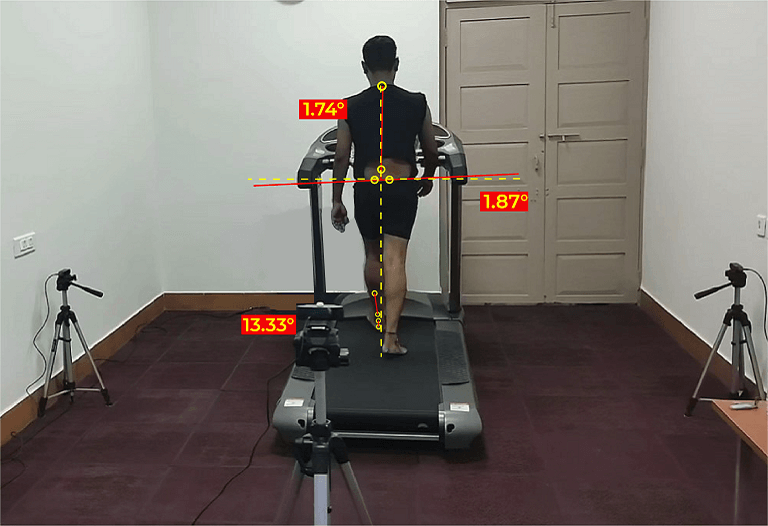
Quantitative Gait Analysis
You get detailed data on each parameter of an individual's Gait
A. Qualitative gait analysis
1. Visual Observation
Visual gait analysis is the easiest form of gait analysis and does not require any tools or equipment whatsover. The clinician asks the patient to walk on a pathway for a few minutes and tries to identify abnormal gait patterns using visual observation.
Equipment required: None
Advantages
1. Easy to perform
2. No financial investment in equipment
3. Can manage mild gait pathologies which do not require extensive analysis
4. Saves time
5. Saves space
6. Real-time Assessment
Disadvantages
1. Eyes cannot observe high-speed movements
2. Variables like forces, cadence, and joint kinematics are hard to assess without measurements
3. Difficult to track improvements as there is no permanent record of gait
4. Requires the patient to walk multiple times
5. Requires excellent clinical skills
6. There is an increase in inter-rater variability. The criteria for ‘Normal gait’ varies from rater to rater, depending on the experience level
7. Difficult to observe forces
8. Patient understanding of the problem is poor
2. Video-based observation
The clinician records the patient’s gait using a camera and analyses it through a slow-motion video. The analysis is done by replaying the video at slower speeds on a phone/computer and identifying abnormal gait patterns.
Equipment Required: Camera, Camera stand for video stability (Optional)
Advantages
1. Reduces the number of walks done by the patient for analysis
2. Provides visual biofeedback
3. It can be used as an elementary tool for teaching purposes
4. Video makes it easy to zoom and slow down the gait and replay it as per requirement
5. It can be used for pre-post analysis
Disadvantages
1. It does not provide information about forces and muscular activity
2. The accuracy of the analysis depends on the camera placement
3. Scales and Questionnaires
Gait Scales & Questionnaires are assessment forms with well-defined guidelines to analyze gait. Each scale consists of various parameters which are evaluated observationally by the clinician during walking. Every parameter carries an individual score and based on the cumulative score of parameters, gait is classified as normal or abnormal.
Some examples of commonly used gait scales are:
1. Dynamic Gait Index,
2. 6-minute walk test,
3. Timed Up and Go test
4. Edinburgh Visual Gait Score
Equipment required: An online or printed version of the scale, chair, tape, obstacles, Cones, Timer, and Stopwatch.
Advantages
1. Tracking progress becomes easy through pre and post scores
2. Gait scales provide useful information about the functional ability of the patient’s gait
Disadvantages
1. Cannot assess all forms of gait, especially if a patient is using assistive devices.
2. Most scales can only comment on whether the gait is normal or not. They don’t provide much information on the factors causing the abnormal gait, for, eg. The distance covered in 6 minutes is used as the outcome 6-minute walking test. This parameter is very superficial as many factors could result in a reduced distance covered in the time duration.
3. Questionnaires need to be translated into the required language.
B. Quantitative gait analysis
As the name suggests, ‘Quantitative’ methods of gait analysis include objective measurements of gait using various tools. The type of analyses that come under this category are –
1. Kinematic analysis – Kinematic analysis is the foundational element of every gait lab. This method involves the measurement of lower & upper body joint motion during gait. The assessment includes measurement of joint angles, Range of motion (ROM), and Spatio-temporal parameters (speed, stance phase% etc.).
2. Kinetic Analysis – This analysis aims to understand the forces involved in joint motions.
3. EMG Analysis – EMG Analysis provides essential information on electrical activity and firing patterns of different muscles during the various phases of Gait.
1. KINEMATIC GAIT ANALYSIS
a. TWO DIMENSIONAL (2D) GAIT ANALYSIS
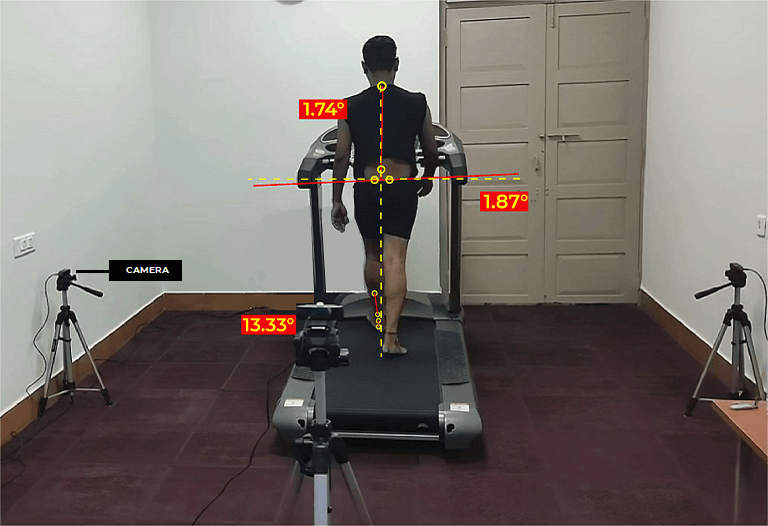
In a 2D gait analysis, the clinician places self-adhesive markers on various anatomical landmarks of the patient.
After marker placement, the patient starts walking along a pathway while the clinician uses cameras to capture the gait pattern from various angles. The captured video is then uploaded & analysed in a gait software. After completing the analysis, the software generates a complete report with information on joint kinematics, spatial and temporal parameters. Good systems can also provide reference values for comparison with normal gait.
Equipment Required: Self-adhesive markers, Digital cameras, Tripod Stand, Motion Analysis Software, Treadmill (if needed)
Advantage
1. More accurate than qualitative video analysis
2. Affordable Kinematic set-up
3. 2D systems do not require technical expertise and can be easily operated by the clinician.
4. Patient understanding of the problem is excellent
5. It can easily be used for pre-post analysis
Disadvantage
1. Difficult to detect rotatory movements around a vertical axis.
2. It does not provide information about forces and muscle activity.
3. The accuracy of the analysis depends on the placement of markers on anatomical landmarks.
b. THREE DIMENSIONAL (3D) GAIT ANALYSIS
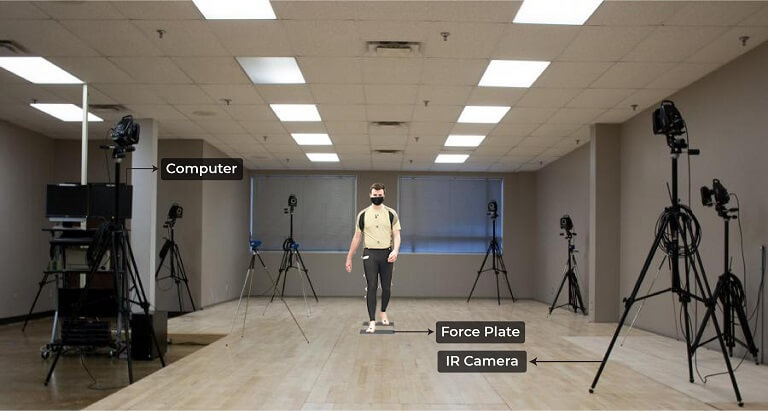
The setup and analysis process of 3D systems is primarily similar to 2D. However, 3D systems require specialised equipment and infrastructure. Unlike many 2D systems, 3D systems also offer force plates and EMG integration options, increasing their applicability in research.
Equipment required: High-speed infrared cameras (3-8 cameras), retro-reflective markers,
Calibration frames, advanced computers with increased computational capacity, force plate / EMG devices (if needed)
Advantages
1. Useful for research purposes
2. It provides the highest level of accuracy and is therefore considered the gold standard.
3. Can measure data from multiple planes
Disadvantages
1. Exponentially Expensive
2. Space Intensive
3. Need of precautions in the lab to avoid detection of any reflective objects as psuedo-markers.
4. Requires training to operate the set-up. In most cases, a biomechanist is needed.
5. Requires clinician’s technical expertise in data interpretation
c. ELECTRO-GONIOMETER/ POTENTIOMETER
An electrical goniometer is attached to a joint for measuring the range of motion data while walking. It can give faster data regarding joint angles
Equipment required: Electro goniometer, Straps, Connection to electrical output
Advantages
1. Portable
2. Affordable
Disadvantages
1. Uncomfortable to wear
2. Difficult to measure motion in smaller body segments with smaller anatomical landmarks, typically foot motion.
3. It can give inaccurate joint motion data if thick, soft tissue is present over a joint.
2. KINETIC GAIT ANALYSIS
a. FORCE PLATES & PLANTAR PRESSURE SYSTEMS
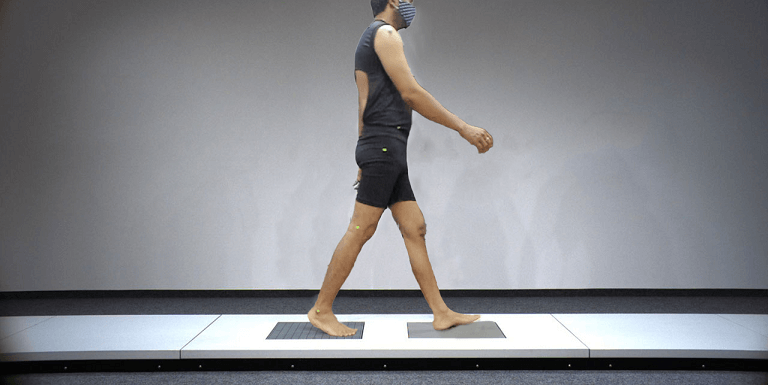
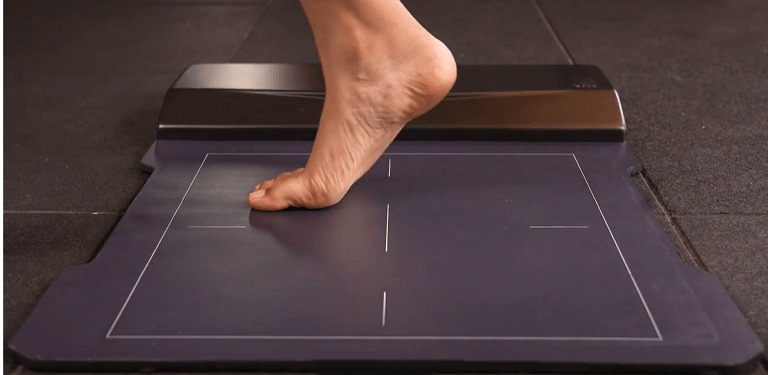
A force plate is a platform embedded with sensors usually placed in the middle of the walkway for gait analysis. As the patient walks over the platform, it provides the magnitude and direction of ground reaction force. Most platforms are submerged inside a cavity in the walkway to ensure a more natural gait pattern and are made invisible to the patient.
Similar to a force plate, a pressure plate provides plantar pressure distribution in the feet while walking.
Equipment required: Force Plates, Pressure plate, Photoelastic optical systems.
Advantages
1. Can accurately calculate ground reaction forces and centre of pressure.
2. No attachment is required to the body.
3. Very useful in prosthetic limb design.
Disadvantages
1. Expensive
2. Requires to be done along with kinematic analysis
3. Lack of good normative values for force plates make it difficult to compare data with normal gait.
4. Can trigger alterations in step length (to ensure proper foot contact) if the platform is visible to the patient.
b. IN-SHOE PLANTAR PRESSURE SYSTEMS
Pressure-detecting soles are fitted in the shoes to measure plantar pressure and are used to understand foot structure and function.
Advantages
1. Portable
2. Can be used to understand the efficacy of customized insoles
3. Can be fitted to various-sized shoes
4. Provides distributed force measurements
Disadvantages
1. Wired in-shoe systems are uncomfortable to wear due to cables running inside the shoes.
2. Number of sensors is usually low which reduces data accuracy.
3. Less effective on uneven surfaces
4. Lack of good normative values for in-shoe systems make it difficult to compare data with normal gait.
c. INERTIAL MEASUREMENT UNITS (IMU'S)
Sensors are placed on the body to record acceleration, angular velocity, and body orientation in space. The accuracy of many IMUs is comparable with 3D kinematic systems.
Equipment required: Accelerometers, Gyroscopes
Advantages
1. It does not need a controlled environment and can be used anywhere.
Disadvantages
1. It can produce inaccurate data if much movement is present between the skin and the sensor.
2. Requires accurate placement of the sensor on the body
3. Difficult to measure motion in smaller body segments with smaller anatomical landmarks, typically foot motion.
3. ELECTROMYOGRAPHY (EMG) ANALYSIS
Electrodes are placed over the skin, which receives input from a muscle’s action potential. When the patient starts walking, the EMG provides information about electrical activity and firing patterns of different muscles during the various phases of Gait.
Equipment Required: EMG Machine, Headphones, Electrodes, Gel
Advantages
1. It provides immediate responses
2. Depending on the type of electrodes, superficial and deep muscle activity is detected.
Disadvantages
1. EMG data can be affected by medications
2. Needle EMG setup can be uncomfortable.
3. Skin impedance can alter the data.

PART II: Applications of Gait Analysis
The primary objective of gait analysis is to help us identify abnormal gait patterns affecting the patient and also study their underlying causes. This information is extremely useful in designing targeted rehab programs, planning surgical interventions or fabricating orthotics & prosthetics.
A. For clinical purposes
a. Musculoskeletal Conditions (In cases of Pain, Injury, and Tissue Pathology)
Acute and chronic pain resulting from idiopathic or traumatic conditions produces gait changes as muscle imbalances, compensatory strategy and guarding responses. An analysis provides data on the parameters affected by tissue pathology.
b. Neurological Conditions: (In cases of Cerebral Palsy, Parkinsonism, Stroke, Multiple Sclerosis, Muscular Dystrophy, and Spinal Cord Injury)
Analysis determines the recovery or the progressive nature of the condition. Therefore, it is helpful for the prescription or modification of assistive devices.
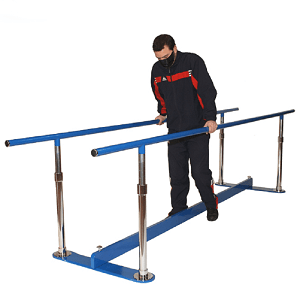
c. Cardio-respiratory conditions: (In cases of CABG, COPD)
These groups of conditions may not require a biomechanical analysis but a more functional analysis. One way a biomechanical analysis may be helpful is to find out if the patient’s gait is causing fatigue through excess movements or unnecessary energy expenditure.
d. Sports Conditions: (In cases of Prehab, Performance optimisation, Footwear Assessment)
Performing a gait analysis provides data regarding joint loading, pathological movement patterns, the effect of sports footwear, issues in the sport technique and solutions for optimising biomechanics for better performance.
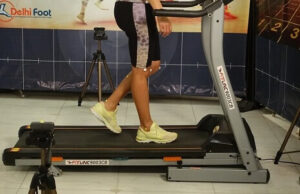
e. Surgery: (In cases of Amputation, Ligament, Fractures)
Gait analysis in this field has significant applications in Gait Training and Retraining and providing feedback on the effects of the interventions, and keeping track of progressions through pre-post analysis.
B. For research purposes
a. To test a gait rehab intervention
b. To test a gait analysis tool
c. To test assistive devices
d. To report notable findings
C. When 'not' to do a gait analysis
Gait parameters are a poor measure of predicting injury. When deviations are detected, they are more likely a result of pathology rather than a cause of pathology. So, if a patient is walking fine or with a supposed “deviation” but does not complain of pain or reduced performance, it’s unnecessary to conduct an analysis.
Also, it is not required as a part of a routine physiotherapy screening.
While there are various methods to perform Gait Analysis, they remain an adjunct. Interpretation of the data and the subsequent clinical decisions highly depend on the clinician’s knowledge and expertise in Gait.
We hope this helped break down the different methods available to perform a good-quality gait analysis at your center! Which method do you feel is best for your center? Comment below!
Setting up a gait lab is now easier than ever. To learn more about Gait and GaitON’s Gait analysis system, contact us today!
Since you’re here…
…we have a small favor to ask. More people are reading our blogs everyday, and each week we bring you compelling content to help you treat your patients better. Please take a moment to share the articles on social media, engage the authors with questions and comments below, and link to articles when appropriate if you have a blog or participate on forums of related topics. — Team Auptimo
The information found within this site is for general information only and should not be treated as a substitute for professional advice from a licensed Physiotherapist. Any application of exercises and diagnostic tests suggested is at the reader’s sole discretion and risk.
ABOUT THE AUTHOR

GAYATRI SURESH (PT)
Gayatri Suresh (PT) is a Biomechanist who has completed her B.P.Th from DES College of Physiotherapy and M.P.T (Biomechanics) from SRM College of Physiotherapy, SRMIST. Her field of clinical expertise is in movement assessments through video analysis. Apart from her work at Auptimo, she works as a Clinical Specialist at Rehabilitation Research and Device Development, IIT Madras. She has been conferred with gold medals for her Research presentations and for securing First rank with distinction in her MPT degree respectively
REFERENCES:
1. Gait Analysis: An Introduction, Micheal W. Whittle
2. Moissenet, Florent & Armand, Stéphane. (2015). Qualitative and quantitative methods of assessing gait disorders.